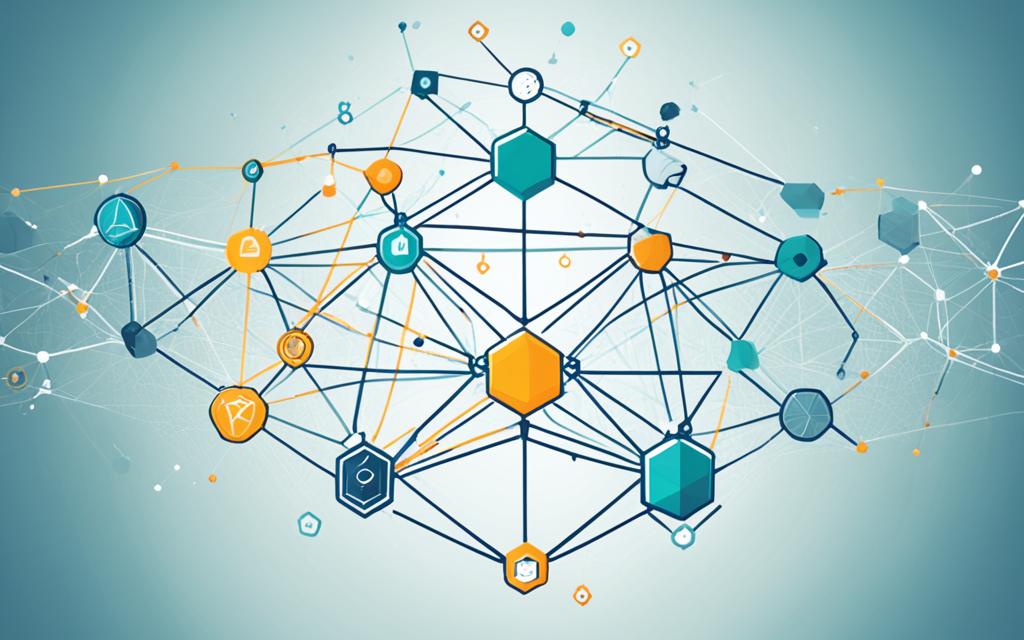Table of Contents
To create your own blockchain, you’ll start with several steps. These steps will help you build a blockchain. You can start from scratch or use tools that are already available. This way, you can explore the world of blockchain tech.
Key Takeaways
- You have four options to create your own cryptocurrency: create your own blockchain and native cryptocurrency, modify the code of an existing blockchain, establish a new cryptocurrency on an existing blockchain, or hire a blockchain developer to create a cryptocurrency for you1.
- Proficiency in programming languages like Python, C++, Java, Ruby, Solidity, or others is required for creating a cryptocurrency1.
- Creating your own blockchain and cryptocurrency involves choosing a consensus mechanism, designing the blockchain architecture, and ensuring legal compliance1.
- Modifying the code of an existing blockchain requires working with an open-source platform and obtaining professional legal advice1.
- Establishing a new cryptocurrency on an existing blockchain involves choosing a blockchain platform, creating the token, and minting the new cryptocurrency1.
- Hiring a blockchain developer can be done through BaaS (Blockchain-as-a-Service) companies1.
- There are pros and cons to making a cryptocurrency. You get to customise but it needs tech skills, time, and upkeep1.
- Before making a cryptocurrency, think about the money, tech skills, advertising, and market competition1.
- Blockchain technology has various uses. It can check IDs and find fraud. By 2030, it might raise the world’s economy by $1.76 trillion2.
- Blockchain brings good things like more safety, faster deals, clear data, and lower costs2.
- It’s used in banking, health, farming, making software, and shipping2.
- Platforms such as Ethereum, Ripple, Stellar, and Corda let you make different blockchain things2.
- Companies in finance can save up to $12,000,000 each year by using blockchain3.
- Platforms like Solana, Algorand, and Cardano handle a lot of deals quickly3.
- Ethereum has the biggest group of users in blockchains3.
Understanding Blockchain Technology
Before you dive into creating a blockchain, it’s important to grasp the basic ideas behind this technology. It’s crucial to note that blockchain isn’t just Bitcoin or a form of digital cash. Actually, it’s a collection of tech tools that came before the idea of Bitcoin.
Blockchain relies on things like Proof of Work (PoW) and Proof of Stake (PoS) for its operation4. These methods help confirm and secure the deals made within the network. PoW asks users to tackle tricky maths problems for approval. On the other hand, PoS is a more energy-efficient way which grows easier as more people engage.
Its impact now reaches well beyond money apps into banking, health, and tracking products5. Used in these sectors, it acts like a shared, trusted book that keeps info safe and consistent. This ledger makes deals clearer, unchangeable, and privacy focused.
When making your blockchain, you can pick from different programming languages and tools. The core of many blockchains is coded in languages like C/C++, Go, and Java4. These come with perks like connecting easily with others.
Knowing the various blockchain options is key for creation. Platforms like Ethereum and Hyperledger exist for building unique blockchains4. They offer cool perks such as being able to make smart deals, grow well, and work with others smoothly.
The choice of where you put your blockchain and who gets to join is also important4. You can host it in a cloud or keep it to yourself, or even do both. Some blockchains only let certain people join, making the use of it more private. But others are open to everyone, keeping things more public and inclusive.
Oh, and don’t forget about the rules! Making sure your blockchain plays by the right laws is a must, especially in fields like finances and health4. Sticking to the laws is how you make sure your blockchain runs smoothly and safely in these areas.
It’s smart to test your blockchain first with a smaller project4. This pilot run helps find and fix any big problems early on. It makes the road to the big launch smoother and less risky.
Then, once your blockchain is out there, keeping it fresh and running smoothly is important. This means regularly updating the software, checking its performance, and making sure it can handle more work as needed4.
Prerequisites for Creating a Blockchain
To make a blockchain, you need to be good with programming. This means you should know about decentralized systems, cryptography, and algorithms6. It’s also helpful to be familiar with languages like JavaScript, Go, or Python for building the blockchain’s basic features6. Many languages, including C/C++, Java, Rust, Haskell, and Ruby, play a part in blockchain creation6. Platforms like Ethereum mix various languages, making it easier for more people to develop blockchains6. Knowing cryptography well is essential for keeping blockchain transactions safe6. The structure of blockchain, based on decentralized systems and peer-to-peer networks, allows everyone to agree on the data without a central controller6. Lastly, an understanding of data management helps in storing and finding information quickly on the blockchain6.
Benefits of Blockchain Technology
Blockchain brings lots of good things for different fields. It cuts out the middleman, letting people deal directly with each other6. Its unchangeable record means all data is clear and trustworthy6. Because it’s spread out and uses secret codes, blockchain is very safe6. There are no central weak spots, so it’s hard for hackers to damage6. Plus, it’s a secure and efficient way to keep and double-check information, making fraud less likely6.
| Main Types of Blockchain | Description |
|---|---|
| Private | Internal use, limited to a specific group of participants |
| Public | Visible to everyone, decentralized and open for anyone to participate |
| Hybrid | A combination of private and public blockchain, offering flexibility and customization |
Understanding blockchain starts with knowing a few key ideas. Hash functions and digital signatures keep data safe6. Once data’s in the blockchain, it can’t be changed6. A network of equals shares and verifies the information on the blockchain6. Different agreeable ways make sure everyone’s on the same page about the blockchain’s status6. Special ways to check blocks keep the blockchain correct and trustworthy6.
Blockchain is changing the way we do things in many fields. It makes land ownership records safe and direct in real estate, avoiding go-betweens6. In health, it guards patient data and makes sharing info easy and safe6. Finance sees less tax, fewer middlemen, and quicker deals with blockchain, plus more security6. Supply chains benefit from blockchain by making tracking and checking products clear and reliable6. It’s important in keeping online attacks away and improving how we safeguard our information6.
How Does Blockchain Work?
Blockchain is like a secure diary. It keeps a record of transactions and information in a special way. It does this through a connected chain of blocks7.
“Blockchain technology stores transactional records in a distributed ledger, ensuring that transactions are duplicated and distributed across a network of computers.”7
“Digital le…nature for better safety.”7
This chain is not kept in one place. It’s spread over many computers. This makes it safe from being changed wrongly. Also, every block is like a new page linked to the last one, keeping everything in order7.
When a block is created, its link to the last block is hidden in a complex way. This is thanks to something called cryptographic hashing. Basically, it turns the data into a secret code (hash value) no one else can make sense of. That way, the block stays safe against tampering7.
For a new block to be added, everyone in the network must agree it’s okay. This stops false information from being added78.
“A blockchain consists of blocks linked together using cryptographic techniques, forming a chain of data that is secured through a consensus mechanism.”7
People who help make these decisions and check everything are called miners. They use their computers to solve puzzles. If they solve it, they earn a reward8.
The time it takes to add a block may change. Some blockchains are quicker but could have more problems. It’s like making a quick decision which might sometimes not be the best7.
Sometimes, the history of the chain might split into two. This could make new coins or change the old ones. It’s called a hard fork7.
“Hard forks in blockchain result in a permanent divergence in the chain’s history, potentially creating new cryptocurrencies or splitting existing ones.”7
The way blockchain works puts the power in many hands, not just one. This makes things more open and safe7.
Once a transaction is checked and added to a block, there’s no going back. This makes blockchain very reliable7.
“Finality in a blockchain ensures the irreversible confirmation of transactions once they are added to a block and confirmed by the network.”7
Anybody can help with the blockchain. It’s built so that everyone can take part and make it stronger. This makes it more safe and trustworthy7.
“Openness in blockchain encourages inclusivity and transparency, allowing anyone to join the network, validate transactions, and add new blocks to the chain.”7
With public blockchains, everything is visible to everyone. This helps keep the system honest and fair7.
To sum up, blockchain is a smart, safe way to keep records. It uses blocked chains to protect information. It uses special codes and checks to make sure everything is true. This makes it a great way to trust information and do business78.

Benefits of Using Blockchain
Blockchain has a lot of benefits for different types of businesses. It’s gaining popularity because of this.
- Removal of intermediaries: This tech kicks out the middlemen. It lets people do deals directly, cutting down on extra costs.
- Immutable ledger: When something goes into the blockchain, it can’t be changed. This makes a super-safe record that everyone can trust.
- Transparency: Everyone can peek at the same records. This means less chance for cheating or hidden tricks.
- Security: Special codes keep data safe. It’s like putting everything in an unbreakable box, stopping wrong people from sneaking in.
- Reliability: Blockchain’s power comes from not being in one place. It’s like spreading the risk, making it stronger.
(source9)
(source9)
(source9)
These upsides change a lot of industries. For example, in chains of supply and food, blockchain boosts trust. It lets people track things easily, coordinates work, and handles problems quickly.
(source9)
Banking and finances see good changes too. Blockchain cuts down on rules and slows, which makes jobs smoother. It also makes world trade and banking for folk better.
(source9)
In health, blockchain makes patient records safer. It links doctors, insurers, and lookers into a big trustworthy network.
(source9)
Places that make meds like blockchain. It checks meds from start to shops, stopping fakes and helping in quick recalls.
(source9)
Governments use blockchain for safe sharing of data, keeping up with laws, and new ways for deals and IDs.
(source9)
Insurers like it for cutting down on hand jobs, like taking in claims. This speeds things up, stops cheats, and saves cash.
(source9)
| Blockchain Platforms and Applications to Know | |
|---|---|
| Bitcoin | Bitcoin is the first and most well-known blockchain platform, primarily used for decentralized digital currency transactions. |
| Ethereum | Ethereum is a blockchain platform that enables the development of smart contracts and decentralized applications (DApps). |
| Hyperledger Fabric | Hyperledger Fabric is an open-source blockchain platform focused on enterprise use cases, providing customizable permissioned networks. |
| EOS | EOS is a blockchain platform designed for building scalable and decentralized applications. |
| Chainlink | Chainlink is a decentralized oracle network that enables smart contracts to securely interact with real-world data and external APIs. |
| Cardano | Cardano is a blockchain platform focused on sustainability, scalability, and security, aiming to provide a robust infrastructure for the development of decentralized applications. |
| Dogecoin | Dogecoin is a cryptocurrency that originated as a meme but gained popularity for its community-driven approach and fast transaction times. |
Blockchain is a huge help for many businesses. It makes work better, clearer, and safer. With many choices, there’s a blockchain for every need.
When to Use Blockchain
Blockchain technology is a powerful tool for many uses. It provides specific benefits in certain situations. This makes it perfect for some scenarios.
Ensuring Proof of Existence and Non-Repudiation
Blockchain can provide proof of existence and non-repudiation for critical data and transactions. It records data in an unchangeable way. This lets anyone check the accuracy of data anytime. This is key in areas like finance, healthcare, and supply chains12.
Decentralization and One Source of Truth
Blockchain enables decentralized systems and serves as a single source of truth. It’s stored on many computers, not just one. So, no single group can control the data. Everyone sees the same truth, which is good for sharing information accurately13.
High Security
Blockchain offers enhanced security measures that protect against cyber threats and unauthorized access. Tech that blocks hacking and changes makes it secure. Since it’s shared, it’s hard to break into. It’s very useful in banking and online shops13.
Specific Use Cases
Blockchain has proven to be effective in several real-world applications. For instance, HSBC sped up trade deals using blockchain to make them in just 24 hours14. Estonia used it for safe public records and easy digital access14. De Beers tracks diamonds to ensure they’re conflict-free, winning customer trust14. Sweden also tried blockchain for property deals to cut fraud14. These cases show how blockchain can change things for the better.
Still, blockchain isn’t right for everything. It might slow down with too many users. So we need to think about how fast and big it can grow13.
Overall, blockchain is a great tool for special cases. It uses an unchangeable ledger, is shared by many, and is very safe. Companies and whole industries can use it to make big changes and work better.
Blockchain Use Cases
Blockchain technology has changed many industries. It provides secure and clear methods for different uses. It helps companies work better, save money, and be safer and more trusted. Let’s look at some important ways it’s being used.
Real Estate
In the real estate world, blockchain changes how people own parts of property. It makes buying and selling bits of houses easier. By using digital tokens, everyone can invest more easily. Also, blockchain keeps deals safe and clear without middlemen, making less chance for mistakes15.
Healthcare
In healthcare, blockchain does a lot of good. It makes managing data smoother, tracks medicine better and makes sure medicine is real. It keeps patient data safe by making it shareable in a very safe way. Also, it helps medication move quicker, knowing where it is all the time15.
Finance
Blockchain is a game-changer for finance. It changes paperwork into digital form, making things quicker and safer. This means less cost and less chance for errors. The rise of DeFi, especially on Ethereum, welcomes lots of new ideas in finance1516.
Supply Chain
Blockchain helps supply chains by keeping an eye on items from start to finish. It helps figure out if things are real or not. With blockchain, moving goods across borders is smoother and safer15.
Cybersecurity
For online safety, blockchain is a powerful tool. It stops tampering with data and keeps info safe. As it’s spread out, it’s hard for bad actors to break in. Using special codes, it makes sure data travels and stays safe17.
User Data Ownership
Blockchain also helps with who owns personal data online. It lets users say who can see their data and proves it’s really theirs. This way, people can take charge of their data more. It makes online life safer and more private17.
Cryptocurrency
Blockchain is the heart of digital money like Bitcoin. It makes buying and keeping digital coins easy, without banks. This makes money moves quicker and includes more people. Also, it’s great for sending money across countries16.
Voting Mechanism
For voting, blockchain could make a big difference. It would keep votes safe and clear, stopping cheats. This kind of voting means more trust in how countries are run. And more people could easily take part in voting17.
| Industry | Use Case | Benefits |
|---|---|---|
| Real Estate | Tokenization of properties for fractional ownership | Increased liquidity and democratized access to the market |
| Healthcare | Secure patient data management and medical supply tracking | Improved patient care and drug authenticity |
| Finance | Digitization of financial instruments and decentralized finance | Increased liquidity, lower costs, and reduced risks |
| Supply Chain | Transparent asset tracking and efficient cross-border transactions | Improved traceability and reduced fraud |
| Cybersecurity | Prevention of data tampering and enhanced data security | Protection against cyber attacks |
| User Data Ownership | Increased control and sovereignty over personal data | Enhanced data privacy and autonomy |
| Cryptocurrency | Secure and transparent digital transactions | Efficient cross-border payments and financial inclusion |
| Voting Mechanism | Secure and tamper-proof voting systems | Increased trust and accessibility in democratic processes |
Blockchain Platforms and Applications to Know
Blockchain technology has changed the game for several industries worldwide. Look at some of the top platforms and applications:
1. Bitcoin
Bitcoin stands out as the first and most popular digital currency. It uses a decentralized system, allowing direct transactions between users. Over the years, it has become a gold standard for online transactions.
Reference: TechTarget18
2. Ethereum
Ethereum isn’t just about cryptocurrency. It’s a platform that lets people create their own digital applications and agreements. Recently, it changed how it works to be more eco-friendly, which is a big step forward.
Reference: Blockchain Council19
3. Hyperledger Fabric
Designed for big businesses, Hyperledger Fabric is both secure and flexible. It’s great for creating private blockchain networks. Many big companies use it for finance, banking, and keeping supply chains in check.
Reference: Konstantinfo20
4. EOS
EOS is all about making blockchain faster and simpler for all. It boasts high speeds for transactions and is set up to be easy for developers.
5. Chainlink
Chainlink helps smart contracts get data they can trust from the real world. It’s all about ensuring that the information used in these digital agreements is correct and safe.
6. Cardano
Cardano takes security and sustainability very seriously. It wants to be a solid base for all kinds of digital applications and contracts.
7. Dogecoin
Originally a joke, Dogecoin has become quite popular. It’s often used for small online tips and donations to charity.
The blockchain business is booming. With so many different services, it’s important to know what they do. This knowledge can lead to great new opportunities.
Types of Blockchains
Blockchains come in three main types: private, public, and hybrid.
Private blockchains are kept inside an organization. They limit who can see them and handle transactions quicker21.
Conversely, public blockchains are open to all. They allow anyone online to join and see the data. These chains are widely used for things like mining and trading cryptocurrencies such as Bitcoin21.
Hybrid blockchains mix features from both private and public types. They offer limited access and privacy but still need verification at times21. This type finds use in many fields like real estate, retail, and health record keeping21.
Choosing the right blockchain type is key. It depends on the application’s needs. Private blockchains keep secrets safe from the public, while public ones focus on being open and gaining trust22. Hybrids strike a balance between these, offering some privacy along with public chain perks22.
Choosing involves looking at security, data privacy, and who needs to access the information2122.
Comparison of Blockchain Types
| Blockchain Type | Characteristics | Use Cases |
|---|---|---|
| Private Blockchain | Restricted access, faster transaction processing | For companies to securely share data within their network |
| Public Blockchain | Open to anyone, transparent transactions | Used by cryptocurrencies, open and trust-focused organisations |
| Hybrid Blockchain | Controls who can see it, offers privacy, and verifies when needed | Found in areas like real estate, retail, and health records |
The blockchain field is growing fast, with an expected 72.9% annual growth until 202823. Knowing the types is vital for finding the right fit for various uses. Whether private, public, or hybrid, each has its special strengths for changing sectors and improving how we secure and share data23.
Conclusion
Making your own blockchain involves knowing the tech and steps needed. You also have to pick the right platform. This lets you use blockchain’s advantages in many areas.
To make your blockchain in 2024, follow this guide [1]. Learn about popular ways for blockchains to agree on things. This includes PoW, PoS, DPoS, and PBFT [24]. When choosing a platform, look at its ability to grow, how secure it is, support from others, and how easy it is for developers to use. Platforms like Ethereum, Hyperledger Fabric, Binance Smart Chain, and Polkadot are good to consider [24].
Ethereum is a top platform for DApps but struggles with busy apps [25]. It can only do 20 transactions a second, much less than Visa [25]. So, if your app needs to handle a lot of transactions, you might want to look at other options. Platforms such as Stellar, IOTA, Ripple, EOS, NEM, and NEO have their unique benefits to check out as well [25].
Blockchain is becoming huge in many fields, like finance and healthcare [26]. Big names see it as key for the future industrial revolution [26]. If you’re thinking of making your blockchain, there’s help out there. Try using tutorials and resources, like those for Rust, to get started. You can tweak your blockchain’s consensus, security, scalability, and decentralization to meet your needs [26].
FAQ
What are the steps to create your own blockchain?
To create a blockchain, first, you must understand the tech and concepts. Then, learn about programming and the backbone of this technology. After grasping these, you can start building from scratch. Alternatively, utilise available platforms.
What is blockchain technology?
Blockchain tech isn’t limited to cryptocurrencies like Bitcoin. It consists of several technologies existing before its advent. The main systems are written in various languages.
It works by linking blocks with data such as transactions in a chain. This chain is shared across a network. This creates a secure and decentralised way to store information.
What are the prerequisites for creating a blockchain?
Mastering networking, cryptography, and data structures is essential. Also, knowing programming languages such as JavaScript, Go, or Python is helpful. These skills lay the foundation for creating a blockchain.
How does blockchain work?
The system has a chain of blocks, each with transaction data, encrypted for security. These blocks form a network, ensuring data’s safety and integrity. A consensus algorithm links blocks, verifying their authenticity.
What are the benefits of using blockchain?
Blockchain offers several advantages. It cuts out middlemen, ensuring a secure, unchangeable record of information. It’s transparent, secure, and reliable. These qualities make it invaluable across many sectors.
When should blockchain be used?
Blockchain is best when data integrity and security are top priorities. It’s great for situations requiring decentralisation and high trust. Yet, it’s not fast due to its consensus process.
What are the use cases of blockchain?
Blockchain finds use across diverse sectors. It safeguards land ownership, secures patient records, and simplifies finance for transactions. It also fights cyber threats, empowers data control, handles cryptocurrencies, and supports trust in elections.
What are some popular blockchain platforms and applications?
Top platforms and apps in blockchain include Bitcoin, Ethereum, Chainlink, and Dogecoin. Each offers distinct services, making them suitable for various needs.
What are the types of blockchains?
Blockchains fall into three categories: private, public, and hybrid. Private types are for internal use, public ones invite global access. Hybrids merge these features. Choice depends on the project’s goals.
Source Links
- https://www.investopedia.com/how-to-make-a-cryptocurrency-5215343 – How to Create a Cryptocurrency
- https://crustlab.com/blog/how-to-create-a-blockchain-a-guide-for-building-a-core-blockchain-network/ – A Step-by-step Guide on How to Create a Blockchain
- https://www.antiersolutions.com/101-guide-to-create-your-own-blockchain/ – Know all about how to create your own blockchain
- https://www.raininfotech.com/blogs/creating-your-own-blockchain-network/ – Creating Your Own Blockchain Network
- https://medium.com/@sherief.mursyidi/understanding-blockchain-technology-a-comprehensive-guide-cc7f7eca87d2 – Understanding Blockchain Technology: A Comprehensive Guide
- https://builtin.com/blockchain/create-your-own-blockchain – Create Your Own Blockchain From Scratch | Built In
- https://www.simplilearn.com/tutorials/blockchain-tutorial/blockchain-technology – What is Blockchain Technology? How Does Blockchain Work? [Updated]
- https://www.geeksforgeeks.org/how-does-the-blockchain-work/ – How Does the Blockchain Work? – GeeksforGeeks
- https://www.ibm.com/topics/benefits-of-blockchain – What are the Benefits of Blockchain? | IBM
- https://online.champlain.edu/blog/benefits-blockchain-technology – The Benefits of Blockchain Technology: Building Blockchain Into Your Tech-Driven Career
- https://medium.com/swlh/is-it-hard-to-build-a-blockchain-from-scratch-2662e9b873b7 – Is It Hard to Build a Blockchain From Scratch?
- https://djangostars.com/blog/how-to-build-your-own-blockchain-for-a-financial-product/ – How to Build Your Own Blockchain For a Financial Product
- https://www.xilinx.com/products/design-tools/resources/the-developers-guide-to-blockchain-development.html – The Developer’s Guide to Blockchain Development
- https://binariks.com/blog/guide-to-blockchain-development-process/ – The Ultimate Guide to Blockchain Development Process
- https://consensys.io/blockchain-use-cases – Blockchain Use Cases and Applications by Industry
- https://www.mongodb.com/resources/solutions/use-cases/blockchain-implementation – Blockchain Implementation Guide | All You Need To Know | MongoDB
- https://www.geeksforgeeks.org/creating-your-own-blockchain-network/ – Creating your own Blockchain Network – GeeksforGeeks
- https://www.techtarget.com/searchcio/feature/Top-9-blockchain-platforms-to-consider – Top 9 Blockchain Platforms to Consider in 2024 | TechTarget
- https://www.blockchain-council.org/blockchain/top-10-blockchain-platforms-you-need-to-know-about/ – Top 10 Blockchain Platforms You Need To Know About [UPDATED]
- https://www.konstantinfo.com/blog/blockchain-platforms/ – Top Blockchain Platforms For 2024 to Build Blockchain Applications
- https://www.techtarget.com/searchcio/feature/What-are-the-4-different-types-of-blockchain-technology – What Are the 4 Different Types of Blockchain Technology? | TechTarget
- https://www.7startup.vc/post/4-types-of-blockchains/ – 4 Types of Blockchains – 7startup – Startup Funding Consultants
- https://www.dock.io/post/public-vs-private-blockchains – Public vs. Private Blockchains: Which Is Better?
- https://medium.com/coinmonks/how-to-create-your-own-blockchain-network-in-2024-8cfaf7c64314 – How to Create your Own Blockchain Network in 2024?
- https://hackernoon.com/when-is-it-time-to-build-your-own-blockchain-f3be0a30b826 – When is it Time to Build Your Own Blockchain? | HackerNoon
- https://dev.to/ecj222/how-to-build-a-blockchain-from-scratch-in-rust-46 – How to build a blockchain from scratch in Rust









